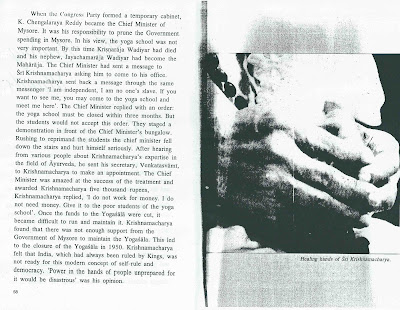Showing in London Feb 2013 - Breath of the Gods. Documentary on Krishnamacharya (links to previous post on the movie)
from The Hindi on the release of Krishnamacharya's Biography in 1997
 |
| Krishnamacharya (top left) under pictures from Yoga Makaranda, in the Sanskrit College Yoga Shala , Mysore |
from The Hindi on the release of Krishnamacharya's Biography in 1997
[THE HINDU]
Friday, April 11, 1997
SECTION: Entertainment
Dedicated to great Yogi
Date: 11-04-1997 :: Pg: 25 :: Col: a
About 90 years ago, 16 year old Krishnamacharya of
Mysore had a dream in which he was directed by Yogi
Nathamuni, a ninth-century South Indian Vaishnava saint,
to go to Alwar Tirunagari in Tamil Nadu. The boy went to
the place and at the premises of a temple of Lord
Vishnu, saw an old man seated under a tamarind tree. The
boy asked him where he could see Yogi Nathamuni. The
latter pointed to a particular direction, which the boy
followed till he reached a mango grove by the side of
the river Tamaraparani.
As Krishnamacharya was very tired and had not eaten, he
fell unconscious. He went into a trance and found
himself in the presence of three sages. Saint Nathamuni,
who appeared in the centre of the trio, explained the
``Yoga Rahasya'' to him. A few hours later, he opened
his eyes to find nobody there. The mango grove had also
disappeared. It was then that he realised that he had
received the ``Yoga Rahasya'' directly from its author
and his ancestor, Yogi Nathamuni.
That teenage boy later went on to become an eminent
teacher- practitioner of Yoga.
The ``Yogacharya'' T. Krishnamacharya was not just an
exponent on Yoga but was a versatile personality. He was
a great scholar in religion, the Vedas, the Upanishadas,
Carnatic music, Ayurveda and astrology. An expert in
many languages, Krishnamacharya who lived between 1888
and 1989, influenced the thinking in various fields such
as Vedanta, Karma and Ayurveda. He wrote many books in
Sanskrit, Kannada and Telugu.
An `acharya' of a high Krishnamacharya said emphasise on
the basic methods of teaching _ ``Desa'' (place),
``Deha'' (constitution), ``Kala'' (time), ``Vrtti''
(Avocation), ``Marga'' (interest) and ``Shakti''
(capacity). His prescription to teachers was: ``Teach
what is inside you, not as it applies to you, to
yourself, but as it applies to the other''.
To make his life and teachings widely known, the
Krishnamacharya Yoga Mandiram (KYM), a 21-year-old
institution named after him to teach Yoga, has brought
out a publication to mark his 108th anniversary.
Releasing the publication at a function held at the
premises of KYM on Tuesday, Mr. C. Subramaniam, former
Maharashtra Governor, praised Krishnamcharya for
propagating and imparting, what he called, the science
of Yoga. Describing Yoga as a great heritage of the
country, he said in the present days of constant
controversies and confrontations, people required it
much more now than at any other time.
Calling upon people to practise Yoga, Mr. Subramaniam
said any amount of reading about it could not fetch the
full benefits and significance of Yoga. As it would help
people realise their talents, the study of Yoga should
be included in school curriculum, the former Governor
said.
Receiving the first copy of the book, Mr Govind
Swaminathan, veteran advocate and one of the students of
Krishnamacharya, reminisced about the days when he was
taught Yoga. He said it was a leveller of one's ego and
it would make those who practised it self-disciplined
persons.
Mr. T.K.V. Desikachar, son of Krishnamacharya and
Managing Trustee of KYM, said the publication was
compiled on the basis of writings of the Yoga exponent
and many oral narrations. Mrs. Mala Srivatsan, Executive
Trustee of KYM, who compiled the publication, said a
section of the book contained `Ashtothrams' (108 hymns
in praise of the ``Yogacharya'').
T. RAMAKRISHNAN
---------------
 |
| Unfortunately long out of print |
Krishnamacharya in Mysore
from Yogacarya Krishnamacharya - The Purnacarya. Edited by Mala Srivatsan
The first biography of Krishnamacharya
 |
| Marla Srivatsan, Editor of the Biography |
More from the biography on these posts
A big thank you again to Eric Shaw for sending me a copy of the book and to whoever passed the copy on to him.
Remember






















































